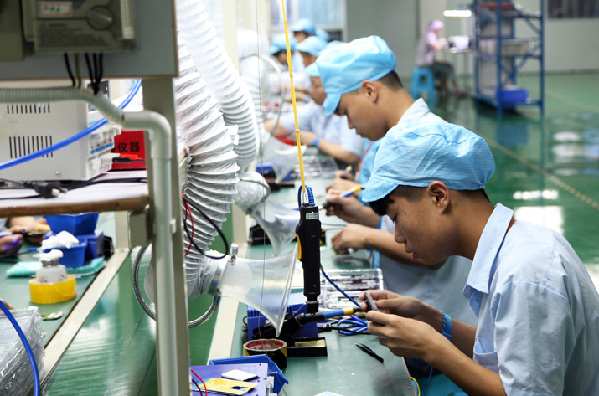Synchronization of new industrial revolution and supply-side reform
- By He Yafei
 0 Comment(s)
0 Comment(s) Print
Print E-mail
China Today, March 22, 2016
E-mail
China Today, March 22, 2016
|
|
|
Workers produce mobile phone components at a plant in Huaying, southwest China’s Sichuan Province, on July 22, 2015 (XINHUA) |
A new industrial revolution marked by new technologies, wide access to the Internet, and computerization across all sectors is changing the world. Lifestyles, thoughts, and the political and social structures of human society are all being affected . The familiar physical and biological environments and contours are being changed by big data. The narrowing gap between virtual reality and real life is creating a new world, a new economy, and a new normal. All this determines the global economy in which China must find its place by deepening its reforms, a key move as structural reform focusing on the supply side comes into focus.
We must observe and analyze China's economic reform in the context of restructuring and transformation of the world economy but also from the perspective of the new industrial revolution (the fourth industrial revolution), the supply-side structural reform, and the relationship between the two.
Facing Increased Risks
After decades of economic globalization, trade and investment continue to grow at a rapid pace. Industrialization is taking off in many countries, creating new emerging economies. The world GDP now exceeds US $70 trillion. In purchasing power parity (PPP), this represents US $118 trillion. In terms of PPP, emerging economies in 2015 accounted for more than half of the global GDP, or 57.6 percent, accounting for more than two-thirds of global economic growth, exactly 68 percent, and China alone represents half of that figure.
However, it is clear that this pattern of development has reached its limits and the guiding thought has to be renewed. Some U.S. economists now believe that many countries in Latin America, Asia, and Africa have been wrong to blindly follow the neo-liberal policies advocated by the IMF and the World Bank, supported by the West, especially the United States. The result is the current recession and stagnation in these countries. The 2008 financial crisis is also the result of the shortsighted economic and financial policies that were enforced for too long. To this day the global economy is suffering the consequences of this crisis.
The risks are increasing: while economic recovery stalls in developed countries, economic growth in emerging economies and developing countries has slowed down. The business cycle, monetary policy of the Fed, and a strong dollar weigh on commodity prices, particularly on crude oil. Countries exporting natural resources, such as Brazil, Russia, South Africa, and Indonesia, are affected by the debt crisis, a lowering of credit, capital flight, and currency devaluation. These factors are already having an effect: the global economy is entering a deep restructuring period with the distribution of wealth and redistribution of interests among various actors accelerating.
The monetary policies of major economies are diverging, causing the external environment for economic development of emerging countries to deteriorate and making it harder for these countries to orient domestic regulation and restructuring. In a time of greater interdependence than ever between developed and developing countries, the proliferation of risks and interactions between them could trigger a crisis that could radiate out from a weak link in the world economy, a scenario we should all be alerted about.






